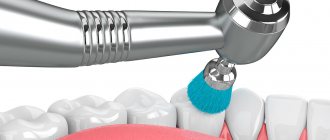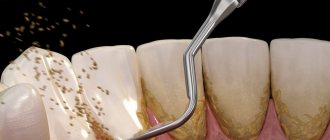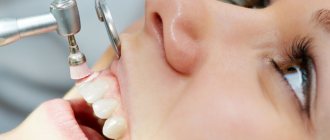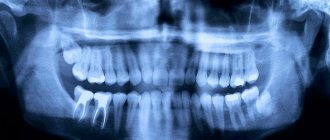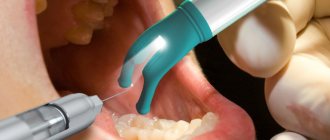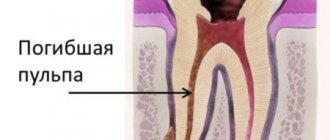Tooth extraction is a very serious procedure, even if it happens quickly and without complications. It always requires increased responsibility on the part of the patient, so it is important to know what rules of care must be followed. The dental surgeon should tell you about them in detail. But to make it easier for you to understand these recommendations, we have systematized them taking into account the specifics of each typical case.
If after tooth extraction the cheek swells and slight swelling appears, then this is considered normal. You should also not be alarmed by mild pain in the tooth socket or an increase in body temperature to 38°C (especially at night). These are all consequences of the inflammatory process. The listed phenomena should disappear on their own after 1-2 days.
Procedure immediately after removal
Tooth extraction is accompanied by a number of activities performed before and after the procedure:
- Do not keep the cotton swab applied by the doctor for longer than 15 minutes. It must be carefully removed so as not to disturb the blood clot. If this is done too late, the wound may become infected, as this is a favorable environment for bacteria to multiply.
- To reduce swelling and relieve pain, apply cold to the cheek, such as ice or frozen food wrapped in a towel. Keep it on your cheek for 5 minutes with constant breaks. Usually 3-5 approaches are enough, but for this, cold water must be applied in the first 4 hours after the removal procedure.
- Sometimes the dentist uses a hemostatic sponge if the bleeding does not stop for a long time. This often happens after wisdom tooth removal. This sponge has an adsorbent, antiseptic, analgesic effect and, in addition, contains the drug alvostasis. It is placed in the hole, and the patient is allowed to perform superficial application only if necessary.
- For severe pain, it is recommended to take painkillers like analgin, tempalgin, spasmalgon, ketanov, ibuprofen, etc. But it is better to consult a dentist about this, since all of the listed medications have a number of contraindications.
- After tooth extraction, you should not drink or eat for 2-4 hours. But it all depends on the complexity of the procedure. So, if several teeth were removed at once or we are talking about a case with suppuration, inflammation or a full-fledged operation with sutures, then this period may be longer. If you really want to drink, you can do this through a straw and in very small sips; optimally, water at room temperature. Under no circumstances should you drink drinks containing alcohol, as it can cause bleeding due to its diluting effect.
- You should not smoke on the day you had a tooth removed, as nicotine has an irritating effect on the tissues of the oral cavity. In addition, each puff involves the formation of a vacuum effect, which poses the risk of dislodging a blood clot and causing a dry socket. If this happens, there is a good chance that you will need medication.
In the first days after filling
The filling easily absorbs coloring pigments, so you should adjust your diet in the first week.
- Avoid coloring foods (coffee, tea, bright berries, beets, red wine, foods with food dyes).
- Avoid sticky and hard foods (nuts, toffee, kozinak). Hard products can deform the surface of the filling, while viscous products, due to their sticky consistency, contribute to the development of caries.
- Food should not be too hot or cold. The seal must be properly secured. Temperature changes, on the contrary, will interfere with a tight seal.
- It is better to chew on the opposite side.
What about smoking?
It is not advisable to smoke immediately after the procedure, since tobacco smoke affects the adhesion of the filling material to the tooth tissue. In addition, smoking can cause the filling to change color and be very different from the enamel.
Home care
After surgery, you can take antiseptic baths on the first day. To do this, you can use furatsilin, chlorhexidine 0.05% or another antiseptic as prescribed by a doctor.
On the second day, you can already brush your teeth using a soft brush. Be careful not to touch the tooth socket, which should still contain a blood clot. After cleaning, you need to rinse the brush in an antiseptic and place it in a sterile place. On the same day, you can take warm baths based on sea salt. To do this, you need to dilute half a tsp. salt in 250-300 ml of water and add 0.25 tsp. soda
Sometimes doctors recommend baths with decoctions for healing. This can be oak bark, elecampane, sage, St. John's wort, chamomile and other plants.
If the filling is temporary
A temporary filling is usually placed for 1 to 2 weeks, so it is not as durable as a permanent one. You don’t need to be afraid to brush your teeth, but you shouldn’t put too much pressure on the tooth while brushing. It is also recommended to avoid chewy foods and chew on the opposite side.
Hygiene after tooth filling
In general, oral care after a filling is installed is no different from usual.
| Brush your teeth twice a day for 2 – 3 minutes. It is better to use a brush with soft bristles that does not scratch the enamel and the surface of the filling. |
| Try not to brush your teeth with abrasive whitening toothpastes. |
| As an addition to daily care, we recommend using an irrigator. It cleans hard-to-reach places from food debris without harming enamel, gums and fillings. |
What not to do?
The postoperative period after tooth extraction is 5-7 days. At this time, you need to be attentive to your health, measure your temperature, and monitor for bleeding. If the pain persists for more than 2 days or intensifies (or becomes throbbing), you should contact your dentist.
Over time, healthy tissue forms at the site of the blood clot, but this can be disrupted if the area is not properly cared for. After tooth extraction surgery it is not recommended to:
- Taking anticoagulants because they thin the blood.
- Bathing in a hot bath, visiting a bathhouse and sauna. Sudden changes in temperature can be harmful, as they cause spasms or dilate the lumen of blood vessels. As a result, the pain will intensify and bleeding may resume.
- Rinsing the mouth.
- Drinking alcoholic beverages.
- Smoking.
- Spitting, as this may dislodge the blood clot.
- Treatment of other teeth, including caries, earlier than a week after extraction. As a result, infection can occur, since carious teeth contain many bacteria.
- Strenuous physical activity, especially heavy lifting and bending. This is one of the reasons for increased blood pressure, which serves as a provoking factor for the opening of bleeding.
- Chewing food on the “sick” side of the dentition.
- Active facial expressions. If there are sutures in the oral cavity, they can break and even come apart.
What does the canal consist of and why should you clean it?
The inside of the dental canal is filled with pulp. It is a soft tissue penetrated by nerve fibers. In addition, it contains blood and lymphatic vessels and connective tissue. When an inflammatory process occurs in the pulp, the soft tissues inside the canal are also affected. Sooner or later it comes to such an extremely unpleasant thing as their necrotization.
The cause of inflammation can be caries or pulpitis. Therefore, in order to relieve the patient of acute pain and prevent tooth extraction, it is necessary to clean the dental canals of dead tissue.
The capabilities of modern dentistry in the vast majority of cases make it possible to completely cure and save the affected tooth, while just 10 years ago such inflammation invariably led to surgical removal of teeth.
Important! A disease that has become chronic may well be asymptomatic.
Information on the use of drugs
If the procedure was not complicated, it is quite possible that painkillers will not be needed during the recovery period. But it’s better to take an analgesic half an hour before the end of the anesthesia (the doctor will tell you about the approximate time). This will help prevent pain, which is almost inevitable after a complex removal, accompanied by drilling the bone, opening an abscess, cutting out affected tissue, suturing, etc. Drugs such as ketanov, nimesil, nimik, etc. will help you quickly cope with pain. Among other things, they also have an anti-inflammatory effect.
The patient must inform the doctor about his state of health and existing diseases. This is especially important when it comes to arterial hypertension, diabetes, hemophilia, and low platelet levels in the blood. Your dentist should also know if you have a tendency to nosebleeds or have recently had an acute respiratory infection or the flu. In this case, the specialist selects individual methods for caring for the hole.
What exactly is not recommended to eat on a white diet? Stop list of products
The white diet excludes the following foods from the diet:
- black and green tea. By the way, it is green tea that causes plaque to form on teeth extremely quickly. This product should also be excluded from the white diet so that your teeth do not darken after whitening;
- bright sauces: tomato, soy, adjika, ketchup, etc.;
- coffee, cocoa are obvious stop drinks of a transparent diet;
- colored fruits: plums, dark grapes, red apples;
- fruit and vegetable juices, compote, fruit drink;
- chocolate, lollipops, dragees;
- citrus;
- jam;
- egg yolk;
- red wine.
Features of care after wisdom tooth removal
After the wisdom tooth removal procedure, you must adhere to the same general recommendations regarding socket care.
- Relax
- Do not eat solid food or chew on the area where the tooth was.
- Do not rinse your mouth and try not to spit for 24 hours so as not to dislodge the tampon.
- No smoking for 48 hours
- Don't suck in anything
- Do not create a vacuum in the mouth
For such cases, the recovery period is 2 weeks. At this time, a foreign body may be felt in the hole, since it contains medications for healing and suture material. Often, after the removal of a wisdom tooth, the body temperature rises in the evening. Periodic pain in this area is also considered normal. It is sometimes projected onto the ear and cheekbones.
To eliminate the risk of developing pathologies, you should take antibiotics prescribed by a dental surgeon. Typically, the list of approved drugs includes lincomycin, flemoxin and tsifran. The use of anti-inflammatory drugs such as rotokan and compresses is also recommended. Their effect can be enhanced by applications with agents that prevent the growth of bacteria. Before going to bed and every time after eating, you can do a light and very gentle rinse. In two weeks, all unpleasant consequences should pass. If this does not happen, you should definitely visit the dentist.
Advice for pregnant women
In the case of pregnant women, the list of acceptable analgesics and antiseptic drugs is noticeably reduced. You cannot take medications at your own discretion! They should only be prescribed by a doctor. Also during this period, the use of baths, cold compresses and applications with herbal infusions is allowed.
Stages of cleaning dental canals
To properly clean the dental canals, the dentist must carry out the following necessary manipulations (step by step):
- Applying a protective lining to the area adjacent to the affected tooth. First, injection anesthesia is performed (or dental treatment is offered during sleep), and then the doctor places a protective pad around the tooth in the form of a thin sheet of rubber. Since the main goal pursued in the treatment of affected dental canals is to cleanse them of bacteria from the inside, the protective overlay reliably protects the tooth from saliva. After all, saliva contains many bacteria, and if the affected tooth is not isolated, then new colonies of bacteria will again rush into the freshly cleaned dental canals.
- Providing access to the dental nerve . This is why the doctor drills a hole in the tooth. There is no other way to reach the area in need of cleansing. Therefore, the doctor creates this access himself in order to begin treatment as soon as possible. For this, a well-known dental bur is used. With its help, the specialist enters the pulp chamber of the diseased tooth through a tiny hole.
- Cleaning the cavity of a diseased tooth . To clean the inner surface of the tooth cavity, the dentist uses special files—the so-called tools that look like long needles. In fact, these are rather micropiles that perform a similar function. The doctor performs manipulations with the canals, operating with several files of different diameters - from smaller to larger. During the cleaning process, he simultaneously rinses the tooth cavity in order to thoroughly clean the tooth canal along its entire length.
- Closing the dental canal with filling material.
When do you need to see a doctor urgently?
If a high temperature (more than 38 degrees) lasts longer than a day, and severe swelling is observed, accompanied by an unpleasant odor and taste in the mouth, a doctor’s consultation is necessary. You should immediately see a doctor if the bleeding does not stop for more than 10 hours.
Also reasons to contact a specialist are:
- external signs of seam divergence;
- the appearance of pain in the socket that does not subside for more than 3 days, increasing or pulsating;
- mobility of adjacent teeth;
- numbness of the tongue, cheeks and lips;
- soreness of the submandibular lymph nodes.
Do not ignore the recommendations described above, as this can lead to serious complications and long-term treatment, including in a hospital setting.
Sealing
This moment is very important. Today, two main methods are used to fill dental canals: introducing dense cone-shaped gutta-percha pins into the canal (the so-called lateral condensation) and filling a fragment of the dental canal with a heated mass from the same gutta-percha, followed by the introduction of cone-shaped pins (the so-called vertical condensation). Both of them are very effective and allow you to reliably “seal” all additional branches of the main channel.
All filling materials come in two types. The first is sealers, also known as endosealants, that fill the root canal. The second is the so-called fillers, which fill the lumen of the dental canal. Sealers are divided into pastes based on epoxy resins, calcium hydroxide and zinc oxide, as well as cements.
Upon completion of dental treatment while asleep or under anesthesia, the doctor sends the patient for an x-ray - it is important to find out whether the root canals are completely filled with endodontic filling material. If everything went well and the canal is in order, you can proceed to the final part of the process - filling the inlet.
What is better not to do before dental treatment?
Most likely, nothing serious will happen to you, but professionals still do not recommend doing certain things before your scheduled visit to your dentist.
- You cannot drink alcoholic beverages. Even if you are very worried and worried about the outcome of the operation, you should not relieve stress with strong drinks. 12 hours before taking them you should completely exclude them.
“Alcohol and anesthesia are incompatible!”
- It is strictly not recommended to arrive with an empty stomach. On the contrary, you should definitely eat a hearty meal, because after many dental procedures, the doctor prohibits eating for at least several hours.
- You should not take strong sedatives and painkillers, especially without a prescription. This is due to the fact that anesthesia and similar pain-relieving pills affect the same nerve endings, but in completely different ways. Therefore, the anesthetic may not work as effectively or may not help at all. 6 hours before treatment, completely stop taking pills; in extreme cases, you can drink chamomile tea. But if your personal doctor nevertheless prescribed you to take a painkiller, then it is better to follow his advice and purchase exactly the drug he recommended.
Why does a tooth hurt after a filling is installed?
Minor soreness may persist for several days or even a couple of weeks, which is explained by overheating of the tissue due to the use of boron. In some situations, for example, with deep caries or when treating front teeth, increased sensitivity can persist even for several months. But in such a situation, you should still consult a doctor for an x-ray to make sure that there is no infected tissue left under the filling and that inflammation has not affected the nerve.
If the pain intensifies, the filling darkens, black spots appear under it - all this indicates that the treatment was carried out poorly and re-inflammation has begun. This is a reason to see a doctor as soon as possible.
The effect of alcohol on a treated tooth
Some people think that alcohol after dental treatment additionally disinfects the oral cavity, but doctors say the opposite. After dental treatment, especially after treatment of pulpitis or periodontitis, the body needs rest. Not only the daily routine should be gentle, but also the diet, so at this time it is better to give up alcoholic beverages.
Let's tell you why.
- Alcohol can cause bleeding because alcohol dilates blood vessels and increases blood pressure.
- When drinking alcohol, the oral mucosa is irritated, the healing process slows down, and the risk of inflammation increases.
- Alcohol increases the load on the cardiovascular system and liver.
- Alcoholic drinks in combination with an anesthetic can cause headache, weakness, and convulsions.
Despite the fact that the effect of anesthesia wears off on average after two hours, the breakdown products continue to remain in the body for several more days.
When can a light seal be placed?
The photopolymer composition is considered universal, therefore it is widely used in dentistry. There are a large number of pathologies for which the dentist prefers this composite, including:
- caries;
- erosion and necrosis of enamel;
- fluorosis;
- wedge-shaped defect;
- pulpitis and periodontitis (light filling is placed at the final stage of disease treatment);
- dental injuries and chipped enamel;
- pathological abrasion of units (a photopolymer filling is installed for temporary restoration of the tubercles).
In addition, the dentist uses this filling material to give the stump the required size and shape before prosthetics with fixed dentures. Thanks to a wide palette of shades and good strength after hardening, the photopolymer composition is suitable for any units in the series; it is also chosen for aesthetic restoration.
